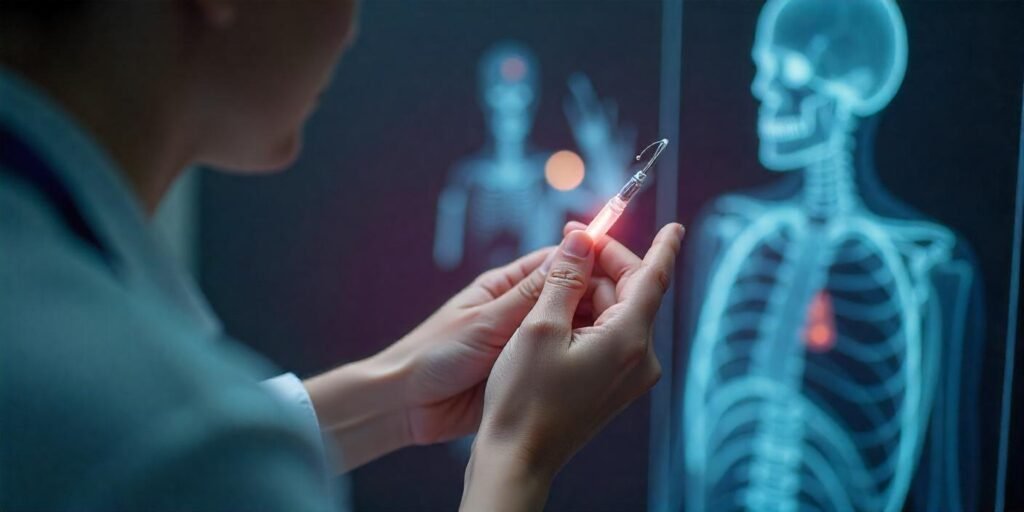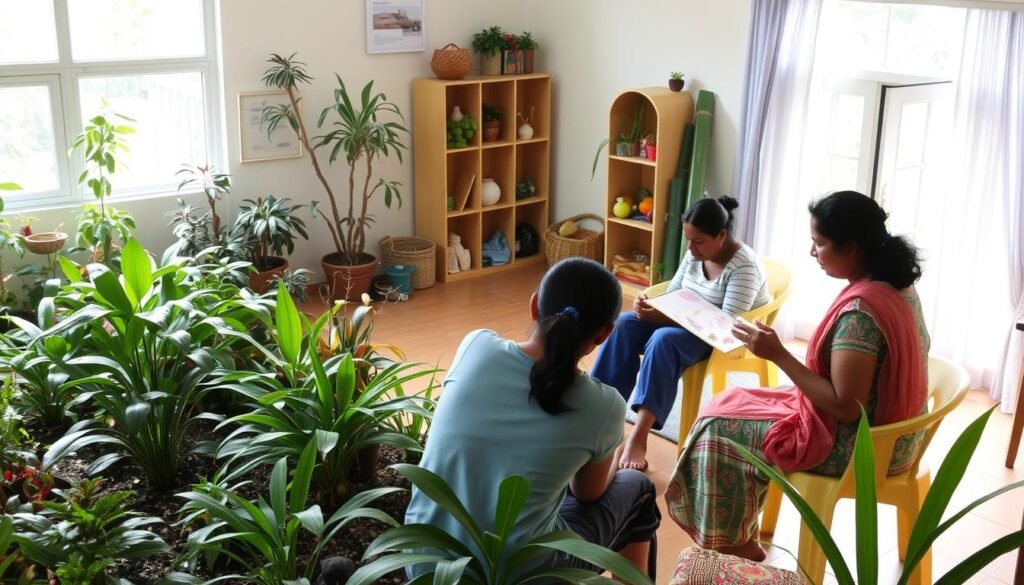This article serves as a comprehensive guide to contemporary leprosy treatment options. The world of medicine is always changing, and so is how we treat leprosy. What are the new ways to fight this old disease? Get ready to explore a detailed guide on the latest treatments for leprosy. It shows how far we’ve come in managing this complex condition.
Did you know leprosy is no longer a death sentence? Let’s look at the big steps forward in treating leprosy. We’ll cover everything from the causes to the best treatments. You’ll learn about the key role of multidrug therapy in fighting this disease.
Table of Contents

Key Takeaways
- Comprehensive overview of modern options for leprosy treatment.
- Insights into the causes, early detection, and diagnostic methods for leprosy
- Detailed analysis of current treatment protocols, including multidrug therapy
- Understanding the medications used and their mechanisms of action
Understanding Leprosy: Causes and Early Detection
Leprosy, also known as Hansen’s disease, is a chronic infection caused by Mycobacterium leprae. It has a long history. Knowing its causes, symptoms, and how to diagnose it is key for early treatment.
Signs and Symptoms to Watch For
The early signs of leprosy can be hard to spot. Common symptoms include:
- Pale or reddish skin patches with decreased sensation
- Numbness and weakness in the hands and feet
- Eye problems, such as corneal damage or blindness
- Nasal congestion, nosebleeds, and voice changes
Risk Factors and Transmission Routes
Leprosy spreads mainly through close contact with untreated people. Key risk factors include:
- Living in areas with poor sanitation and hygiene
- Weakened immune system, like in HIV/AIDS patients
- Genetic predisposition and family history of leprosy

Diagnostic Methods and Tests
Early diagnosis of leprosy is vital to avoid permanent disabilities. Doctors use several methods:
- Physical examination and skin lesion assessment
- Nerve function tests for sensory and motor impairment
- Skin biopsy and lab tests to find M. leprae bacteria
- Imaging like X-rays or MRI to check nerve and bone damage
Understanding leprosy’s causes, symptoms, and diagnosis helps doctors. This is crucial for early detection and preventing disability. It’s a big part of optoins regarding leprosy treatment and prevention of disability.
The Evolution of Leprosy Treatment Through History
Leprosy, a chronic infectious disease, has seen many treatment changes over time. From ancient times to today, how we treat it has changed a lot. This change is thanks to new medical knowledge and the search for better treatments.
In the old days, treatments for leprosy were based on traditional remedies and religious beliefs. People in ancient China, India, and the Middle East used herbal remedies and spiritual practices to help with symptoms. But these early treatments were not very effective and didn’t understand the disease’s causes.
The 1940s brought a big change with dapsone, a new drug. It was called the “first miracle drug” for leprosy. Dapsone was very good at stopping the disease from getting worse and reducing the spread of the bacteria, Mycobacterium leprae. This discovery started a new era in treating leprosy, leading to even better treatments later on.

“Dapsone was a game-changer in the fight against leprosy, offering hope to millions of patients who had long suffered from this debilitating condition.”
As doctors learned more about leprosy, treatments got better. In the 1980s, a new treatment called multidrug therapy (MDT) was introduced. It used dapsone with other drugs like rifampicin and clofazimine. This made treatments more effective and helped prevent drug resistance.
Now, treatments for leprosy have gotten even better. They include new surgeries, rehabilitation, and ways to prevent the disease. This shows how far we’ve come in treating leprosy. It gives hope and better lives to those with the disease.
Current Options for Leprosy Treatment
Leprosy is a chronic disease caused by Mycobacterium leprae bacteria. Treatment has improved a lot over time. Now, a mix of drugs is used to fight the disease and stop it from becoming resistant.
Standard Treatment Protocols
The World Health Organization (WHO) suggests a mix of drugs for leprosy treatment. This mix usually includes rifampicin, clofazimine, and dapsone. The treatment plan changes based on the type of leprosy.
Duration and Effectiveness
Treatment for leprosy lasts from 6 to 12 months for some cases. For others, it can take 12 to 24 months. This treatment works well, curing about 95% of paucibacillary and 85-90% of multibacillary leprosy.
Managing Side Effects
While most patients tolerate the treatment, some may face side effects. For example, rifampicin can change skin color, and clofazimine can cause stomach problems. Doctors help manage these issues to ensure the best results.
The new approach to treating leprosy has greatly improved patient care. It combines the latest drugs and careful side effect management. This has helped reduce the disease’s impact worldwide.
Multidrug Therapy (MDT): The Gold Standard Treatment
Leprosy has been a problem for centuries. But, multidrug therapy (MDT) has become the most effective treatment. It uses three main drugs: dapsone, rifampicin, and clofazimine.
MDT works by targeting different parts of the leprosy infection. Dapsone stops the bacteria from growing. Rifampicin kills the bacteria. Clofazimine helps with the disease’s symptoms.
Using these drugs for 6 to 12 months has changed how we fight leprosy. It treats the infection and lowers the risk of spreading it. This has greatly reduced the number of leprosy cases worldwide.
| Medication | Mechanism of Action | Key Benefits |
|---|---|---|
| Dapsone | Bacteriostatic agent that inhibits bacterial growth | Effective in treating both paucibacillary and multibacillary forms of leprosy |
| Rifampicin | Powerful bactericidal drug that kills the leprosy-causing bacteria | Helps eradicate the infection and prevent transmission |
| Clofazimine | Anti-inflammatory agent that manages symptoms and complications | Reduces nerve damage and skin lesions associated with leprosy |
The success of MDT shows how far we’ve come in treating leprosy. By using these three drugs, doctors can fight the disease well. This helps to reduce suffering and aims for a world without leprosy.
Medications Used in Leprosy Treatment
Leprosy, also known as Hansen’s disease, mainly affects the skin, nerves, and eyes. Three key drugs are used in its treatment: dapsone, rifampicin, and clofazimine. Each drug works differently and is used in specific ways to manage the disease.
Dapsone: Mechanism and Usage
Dapsone has been a main treatment for leprosy since the 1940s. It stops the growth of the leprosy bacteria by blocking a key step in their growth. People take it by mouth and it’s often the first drug used in treatment.
Rifampicin: Administration and Effects
Rifampicin is a powerful antibiotic used in leprosy treatment. It kills the leprosy bacteria by stopping their RNA synthesis. This makes it a key drug in fighting leprosy.
Clofazimine: Benefits and Side Effects
Clofazimine is a dye with anti-inflammatory and antimicrobial effects. It’s used with dapsone and rifampicin to treat leprosy. It helps reduce inflammation and stops the bacteria from growing. However, it can cause skin discoloration, which goes away when the drug is stopped.
| Medication | Mechanism of Action | Administration | Key Benefits | Potential Side Effects |
|---|---|---|---|---|
| Dapsone | Inhibits dihydrofolic acid synthesis | Oral | First-line treatment, part of MDT | Hemolytic anemia, methemoglobinemia |
| Rifampicin | Inhibits RNA synthesis | Oral | Potent bactericidal activity, part of MDT | Hepatotoxicity, gastrointestinal disturbances |
| Clofazimine | Anti-inflammatory and antimicrobial properties | Oral | Reduces inflammation, part of MDT | Skin discoloration, gastrointestinal disturbances |
These three drugs are key in treating leprosy. Used together, they help manage the disease and aid in healing. It’s important for doctors and patients to know how these drugs work and their possible side effects.
Surgical Interventions for Leprosy Complications

While treating leprosy mainly with drugs, sometimes surgery is needed. These surgeries help prevent disabilities and improve life quality for those with leprosy.
Nerve decompression surgery is a common treatment. Leprosy can damage nerves, causing loss of feeling and muscle weakness. This surgery helps relieve pressure on nerves, improving function.
Reconstructive surgery is also key in treating leprosy complications. It fixes eye issues, deformities, and ulcers. This surgery greatly improves a patient’s mental and social health.
| Surgical Intervention | Purpose | Potential Benefits |
|---|---|---|
| Nerve Decompression | Relieve pressure on affected nerves | Restore sensory function and prevent further nerve damage |
| Reconstructive Surgery | Address eye problems, deformities, and ulcers | Improve physical function and appearance, enhance psychological and social well-being |
Choosing surgery for leprosy complications depends on each patient’s needs. Skilled surgeons and a healthcare team work together to find the best treatment.
Combining medicine, surgery, and rehabilitation helps manage leprosy. This approach aims to prevent disability and improve quality of life for those with the disease.

Prevention Strategies and Vaccination
Leprosy is a chronic disease that can be prevented. Vaccination and preventive measures are key. The BCG vaccine is a major tool in fighting leprosy, showing it can lower disease risk.
BCG Vaccine Effectiveness
The BCG vaccine is known for fighting tuberculosis but also helps against leprosy. People who got the BCG vaccine are 60% less likely to get leprosy. This makes BCG vaccination very important, especially in areas where leprosy is common.
Preventive Measures for High-Risk Groups
- Regular screening and early detection: People at high risk, like those close to leprosy patients, should get tested often.
- Chemoprophylaxis: Giving antibiotics like rifampicin to high-risk people can stop leprosy from developing.
- Improved hygiene and sanitation: Good hygiene and clean water and sanitation help prevent leprosy spread.
- Community education and awareness: Teaching people about leprosy and how to prevent it helps communities fight the disease.
Using the BCG vaccine and other preventive steps can help fight leprosy. This can lead to a big reduction in disability caused by the disease.
| Preventive Measure | Effectiveness | Target Group |
|---|---|---|
| BCG Vaccine | Up to 60% reduction in leprosy risk | General population |
| Regular Screening and Early Detection | Facilitates timely diagnosis and treatment | Close contacts of leprosy patients |
| Chemoprophylaxis | Helps prevent disease development | High-risk individuals |
| Improved Hygiene and Sanitation | Reduces transmission risk | Entire community |
| Community Education and Awareness | Empowers people to take preventive action | All community members |
Rehabilitation and Supportive Care
Leprosy is a complex disease that can cause serious physical and social problems. It needs a full treatment and recovery plan. Important parts of managing leprosy include rehabilitation and supportive care. These help prevent disabilities, restore function, and help patients return to society.
Physical therapy is a key part of leprosy rehabilitation. Physiotherapists create special plans for each patient. They work on muscle weakness, joint stiffness, and nerve damage. Exercises, splints, and devices help keep patients mobile and prevent deformities.
Occupational therapy is also vital. Occupational therapists help patients with daily tasks, like self-care and home management. They also help with job skills. This helps patients become more independent and improves their life quality.
Reintegrating patients into society is also crucial. This includes fighting stigma and helping patients go back to their communities. It supports their social and economic health. This approach is key to preventing disability and helping leprosy patients.

Healthcare providers can help leprosy patients regain their independence. They can reintegrate into their communities and live fulfilling lives. This care approach improves physical, social, and mental health. It greatly enhances their quality of life.
Latest Research and Future Treatment Developments
Researchers and doctors are working hard to find new ways to fight leprosy. They are looking into new treatments and ways to manage the disease. This section talks about the latest research and future developments that could improve leprosy treatment and prevention.
Emerging Therapies
New treatments are being explored, besides the current multidrug therapy (MDT). One new approach is using immunotherapeutic agents. These aim to boost the body’s immune system to fight the leprosy bacteria better.
Also, gene-based therapies are being studied. Researchers are looking into gene editing and targeted gene delivery to tackle the genetic factors behind leprosy.
Clinical Trials and Studies
The medical and scientific world is busy with clinical trials and studies. These are important to check if new treatments are safe and work well. They help find out if new ways to treat and prevent leprosy are good.
A recent clinical trial is testing a new leprosy vaccine. It has shown good results in early tests. The trial is checking if the vaccine can protect against leprosy, helping prevent the disease in at-risk groups.
| Emerging Therapy | Mechanism of Action | Current Status |
|---|---|---|
| Immunotherapeutic Agents | Stimulate the immune system to combat leprosy-causing bacteria | Ongoing clinical trials and research |
| Gene-based Therapies | Target and address genetic factors contributing to leprosy | Early-stage research and development |
| Novel Leprosy Vaccine | Provide protection against leprosy infection | Advanced clinical trials underway |
As research and treatment for leprosy advance, new therapies and trials bring hope. They suggest a future where options for leprosy treatment options and leprosy vaccines are better, more available, and change lives for the better.
Conclusion
Modern treatments for leprosy have made a big leap forward. This brings new hope to those dealing with this disease. The use of multidrug therapy (MDT) has been a major breakthrough. It’s a highly effective and easy-to-take approach to treating leprosy.
Finding leprosy early is crucial for a good treatment outcome. It helps prevent serious problems and disabilities later on. Getting the right care, including medical treatment, rehab, and social support, is key to a better life for those with leprosy.
Despite the progress, we still need more research and new treatments for leprosy. As we keep looking for better ways to manage and prevent leprosy, we’re getting closer to wiping it out. Together, we can make sure everyone has a chance to fight against this disease.
FAQ
What are the most common treatment options for leprosy?
Leprosy treatment mainly uses a combination of drugs. This mix includes dapsone, rifampicin, and clofazimine. This treatment is very effective in curing leprosy.
How long does leprosy treatment typically take?
Treatment time varies based on the type of leprosy. For paucibacillary leprosy, it’s 6 to 12 months. Multibacillary leprosy treatment lasts 12 to 24 months. This long treatment is key to a full recovery and stopping the disease’s spread.
What are some common side effects of leprosy medications?
Side effects of leprosy drugs include skin color changes and stomach issues. Liver problems can also occur. But, these issues are usually manageable. Doctors closely watch patients to handle any problems that come up.
Are there any surgical interventions for leprosy complications?
Yes, surgery is sometimes needed for leprosy complications. This includes nerve damage and deformities. The goal is to prevent disabilities and improve life quality.
How effective is the BCG vaccine in preventing leprosy?
The BCG vaccine offers some protection against leprosy. Its effectiveness ranges from 20% to 80%. While not a sure prevention, it’s still recommended for those at high risk.
What kind of rehabilitation and supportive care is available for leprosy patients?
Leprosy patients need comprehensive care. This includes physical therapy to prevent deformities and occupational therapy for daily tasks. Social programs also help with mental health and reintegration. These efforts aim to improve patients’ lives.
What are some of the latest research and future developments in leprosy treatment?
New research is looking into better leprosy treatments. This includes testing new drug combinations and vaccines. These efforts could lead to better disease management and lower global cases.



